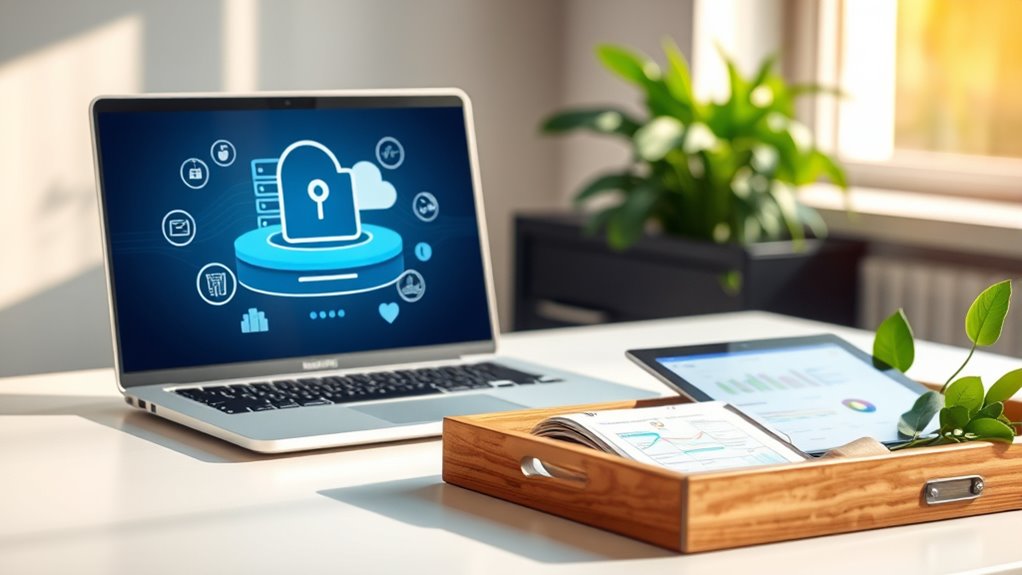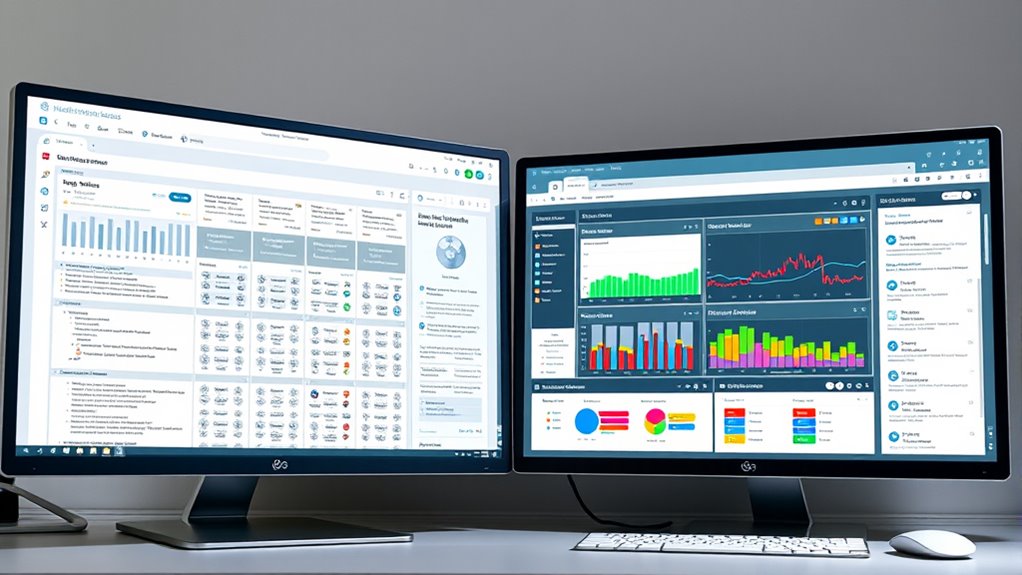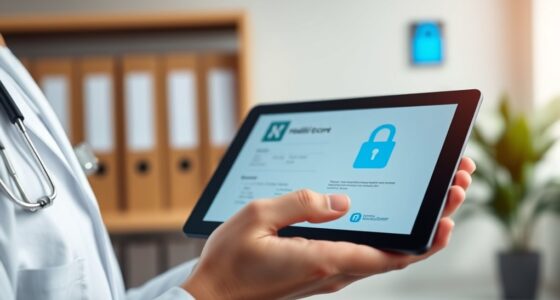Electronic health records (EHRs) are digital charts maintained by healthcare providers, ensuring secure access only for authorized medical staff. Personal health records (PHRs), managed by you, let you collect and review your health data from various sources, giving you more control. While EHRs focus on provider-side security, PHRs require active management to stay secure. Understanding these differences helps protect your privacy and manage your health better—keep exploring to learn more.
Key Takeaways
- EHRs are maintained by healthcare providers, while PHRs are managed by patients.
- EHRs focus on secure, authorized access for medical staff; PHRs empower patient control.
- EHRs facilitate seamless communication among providers; PHRs enable patients to review and share health info.
- EHRs prioritize data security and strict protocols; PHRs require active patient management for security.
- Understanding these differences enhances privacy, data accuracy, and effective health information management.

Have you ever wondered how your health information is managed and shared? Understanding the differences between Electronic Health Records (EHRs) and Personal Health Records (PHRs) can help you better navigate your healthcare journey. EHRs are digital versions of your medical charts maintained by healthcare providers. They are designed to streamline communication among doctors, specialists, and hospitals, guaranteeing everyone involved in your care has access to accurate, up-to-date information. This centralized system emphasizes data security and user access control, meaning only authorized personnel can view or modify your records. These measures are in place to protect your sensitive health data from breaches or unauthorized use. When providers update or review your EHR, they follow strict protocols to safeguard your information, and your access is limited to what’s necessary for your treatment. This structure helps prevent errors, guarantees continuity of care, and maintains the integrity of your health data. Additionally, advances in robotics and automation are increasingly used in healthcare to improve operational efficiency and patient outcomes.
In contrast, PHRs are typically managed by you, the patient. They allow you to collect, store, and review your health information from multiple sources, including your doctor’s office, labs, or pharmacies. PHRs give you more direct control over who can see your information and when. While this empowerment is a major advantage, it also requires you to be vigilant about data security. Since PHRs are often stored online or on personal devices, they can be vulnerable to hacking or unauthorized access if not properly protected. You need to choose secure platforms that use encryption and other safeguards to keep your health data safe. Managing user access is vital—only you should decide who can view or share your PHR, and you should regularly update passwords and security settings to prevent unauthorized access. Unlike EHRs, PHRs aren’t inherently linked to healthcare providers’ systems, so you’re responsible for ensuring the information is accurate and complete.
Both EHRs and PHRs serve important roles in your healthcare. While EHRs facilitate seamless communication among providers and emphasize data security and controlled user access, PHRs empower you to oversee your health information directly. To make the most of these tools, it’s essential to understand how they differ in terms of data security practices and user access. Whether the data is stored behind a secure hospital system or on your personal device, protecting your health information requires awareness and proactive management. By knowing the distinctions, you can better advocate for your privacy, ensure your records are accurate, and use these records to improve your overall health and well-being.
Frequently Asked Questions
How Do PHRS Integrate With EHR Systems?
You can integrate PHRs with EHR systems through data integration and system interoperability. This process allows seamless sharing of health information, enabling you to access accurate, up-to-date data across platforms. By ensuring compatibility between different systems, healthcare providers and patients can effortlessly exchange essential health details, improving care coordination and personal health management. This integration ultimately enhances your overall healthcare experience and promotes better health outcomes.
Can Patients Access Their EHRS Directly?
Imagine your EHR is a diary locked in a safe—yes, you can access it, but with restrictions. You can view your records through patient portals, yet your privacy and data ownership remain safeguarded by strict regulations. While you have rights to see your health information, some details might be limited to ensure security. So, yes, you can access your EHR directly, but your privacy stays a top priority.
Are There Legal Differences Between EHRS and PHRS?
Yes, there are legal differences between EHRs and PHRs. You need to contemplate legal compliance, as EHRs are typically governed by strict regulations like HIPAA, ensuring data security and privacy. Data ownership also varies; healthcare providers own EHR data, while you usually own your PHR data. Knowing these distinctions helps you understand your rights and responsibilities regarding access, privacy, and data management.
How Secure Are Personal Health Records Online?
Your personal health records online are like a delicate fortress, but their security depends on your vigilance. Data encryption shields your information from prying eyes, while user authentication acts as the gatekeeper, ensuring only you access your records. However, vulnerabilities exist if these measures falter or if you share passwords. Staying cautious and using strong, unique passwords helps keep your health data safe in the digital landscape.
Who Is Responsible for Maintaining PHRS?
You are responsible for maintaining your personal health records (PHRs), ensuring your patient privacy and record ownership are protected. While healthcare providers may help you access and update your PHRs, ultimate responsibility for accuracy and security lies with you. You should regularly review your records, keep them secure, and be aware of who has access to maintain control over your information and protect your privacy.
Conclusion
In the world of wellness, understanding the difference between electronic health records and personal health records helps you harness health data’s power. By bridging the boundary between medical management and personal mastery, you become more motivated, mindful, and motivated. Remember, mastering your medical milestones means more than just metrics—it’s about making meaningful, memorable moves toward a healthier, happier you. Take charge, transform tracking, and trust in the triad of technology, transparency, and thriving health.









